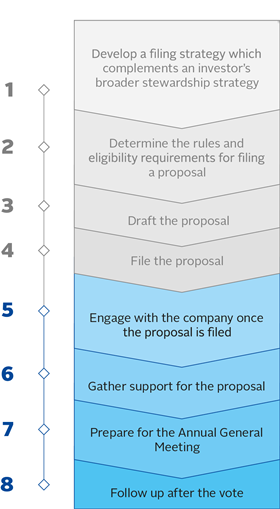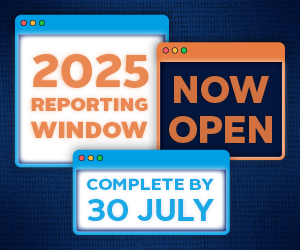By Chloe Horne, Stewardship Specialist, PRI

In many countries, this year’s annual general meeting (AGM) season is fast approaching. A growing number of investors have been busy filing shareholder proposals – that is, putting forward asks to companies, to be voted on by shareholders at their AGMs.
However, drafting and filing the proposal is just one part of the picture. The post-filing actions investors take (see stages 5-8 below) have rarely been more important, as average investor support levels for shareholder proposals fall and sustainability issues become more pressing.
Why has support been falling?
Chart 1: steps involved in filing a shareholder proposal

While the number of ESG-related shareholder proposals filed has grown around 20% between 2021 and 2022,1 average support has fallen from around 32% to 27% in the same period.2
Falling support levels can be explained by several factors. For one, the types of asks put to companies over the last year have been more demanding and prescriptive.3
For example, with many companies having already made long-term commitments to sustainability goals, some filers are now focusing on how companies are implementing their commitments. These asks are often associated with lower shareholder support levels.4 5
Evidence also shows that companies and filers are increasingly willing to have a shareholder proposal withdrawn in exchange for the company committing to action. According to Ceres,6 110 climate-related commitments were made by US companies in 2022 in exchange for withdrawing the proposal, compared to just under 75 the previous year. In this way, filers may achieve their intended outcome and avoid the time and costs associated with the filing process; some companies may even prefer to agree to requested action rather than receive the broader public scrutiny that’s often associated with a proposal being put to an investor vote.
The shareholder proposals left on the ballot will therefore likely include those that filers and companies were unwilling to agree on – including more demanding or ambitious asks, and other asks that are likelier to gain less support.7
Another factor contributing to falling support may be the increasing and misguided opposition to ESG in the US, which may have led to reluctance by some investors to use voting as a tool to make progress on sustainability outcomes, or support proposals that could be seen as controversial.
How can you commit the company to action?
Given the above challenges, we need more effective shareholder proposals and board accountability. This means building support for filed proposals, negotiating well and holding companies to their commitments when proposals have been withdrawn.
Below are some general points we collected over the last year from investors who have filed proposals in different markets. It’s important to note that local rules and legislation (such as proxy solicitation in the US) apply, and to help investors in this area we’ve created country-specific factsheets in eight key markets.
Ensure withdrawn proposals are well negotiated
One of the challenges investors face when agreeing to a commitment in exchange for withdrawing a proposal is companies not holding up their side of the bargain. Where agreements may be made in private, it may be easy for companies to treat their commitment as a low priority, make slow progress, or not make progress at all.8 And without the public forum of an AGM, it may be more difficult for filers to hold companies to account.
So how do you ensure that when you withdraw a proposal, the agreement is sufficiently ambitious, and the company is held to its commitments?
Insights from investors:
- Only consider withdrawing a proposal if the negotiated agreement is in line with your desired outcomes. This means ensuring the commitment and the timeframe to achieving it are proportionate to the urgency and severity of the issue.
- Ask the company to make a public commitment, so the company can be held to account. Encourage the company to explain to shareholders why the proposal was withdrawn and publicly communicate the agreement you made with the company.
- Track the company’s progress and publicise this where possible.
- Be prepared to escalate your concerns if a company fails to deliver. For example, you may consider speaking out publicly against the company, re-filing a similar shareholder proposal the following year (if market rules allow) and voting against (re-)electing board members.
Promote your proposal to maximise shareholder support
A total of 529 shareholder proposals made it to the ballot in the US in 2022, and that doesn’t include the vast number of other votes, such as director elections. AGM season is busy, and many proposals fade into the background, so even the most well-justified, and thoughtfully crafted proposals benefit from more visibility and a convincing campaign.
Many investors we spoke to highlighted that their most supported proposals had benefitted from a strong promotion campaign that targeted shareholders, NGOs and the public.
What does a strong campaign look like?
Insights from investors:
- Prepare and circulate supplementary material that provides investors with more background on the proposal, such as the relevance of the issue to the company, and why investors should support the resolution.
- Reach out to key investors (including the company’s largest shareholders), investor groups and networks, to promote the proposal in line with relevant securities laws and answer any questions they have which may help them make an informed decision. Outreach can be done via one-to-one meetings or exchanges, roundtables, webinars, roadshows, presentations, and through investor platforms and networks such as the PRI’s collaboration platform and resolution database.
- Engage with proxy advisers to ensure they are informed about the proposal and its relevance to investors, and advisers can then make recommendations based on this information.
- Encourage asset owners to engage with their investment managers and ask them to support the proposal if it is aligned with their own company expectations.
- Develop a media plan early and aim to engage with all relevant outlets and channels.
- Work with other proponents who are filing on a similar topic at other companies. You may be able to support each other by sharing experiences (e.g., on how to prepare for the meeting), as well as coordinating promotion through each other’s contacts, networks, press releases and social media.
An ongoing effort
Even after the proposal is withdrawn or voted on, the work doesn’t stop there. You will need to implement your engagement plan based on the voting result. This engagement is crucial to maintain the momentum of the proposal, continue gathering attention on the issue and hold the company accountable to your and other investors’ expectations.
A guide to filing impactful shareholder proposals
For more detail on the above, we’ve published a guide on how to file impactful shareholder proposals, outlining different components of the process, including how to:
- develop a filing strategy that fits into your broader stewardship efforts;
- understand the rules and eligibility requirements for filing a proposal in key markets; and
- draft a comprehensive and persuasive ask.
Alongside this guide, we’ve provided some country-specific factsheets that give an overview of the key legal and technical processes related to filing a shareholder proposal in Australia, Canada, France, Germany, Japan, South Africa, the UK and the US.
The PRI blog aims to contribute to the debate around topical responsible investment issues. It is written by PRI staff members and occasionally guest contributors. Blog authors write in their individual capacity – posts do not necessarily represent a PRI view.
References
1 Proxy Preview (2022) (This figure is based on publicly available information regarding shareholder resolutions filed with US public companies)
2 EY (2022), Four key takeaways from the 2022 proxy season (This figure is based on publicly available information regarding shareholder resolutions filed with S&P 1500 companies)
3Harvard Law School Forum on Corporate Governance (2022), A look back at the 2022 proxy season
4 Harvard Law School Forum on Corporate Governance (2022), A look back at the 2022 proxy season
5 Alongside this, in 2021, changes to rules in the US market made it harder for companies to omit proposals on the grounds of micromanagement, meaning proposals with more prescriptive and granular asks were more likely to make it onto the ballot in the 2022 AGM season. Securities and Exchanges Commission (2021), Staff Legal Bulletin No. 14L
6 This figure does not capture every withdrawal made by filers. See more information on Ceres’ approach to tracking proposals
7 Harvard Law School Forum on Corporate Governance (2022), A look back at the 2022 proxy season
8 Responsible Investor (2020), Meaningful commitment or empty ambition: When is it right to withdraw a shareholder proposal?












